Multi-Scale Analysis of Water Purification Ecosystem Service Flow in Taihu Basin for Land Management and Ecological Compensation
Abstract
1. Introduction
2. Materials and Methods
2.1. Study Area
2.2. Multi-Step Ecosystem-Based Approach
2.3. Data Collection
2.4. Ecosystem Services Assessment
2.4.1. Supply and Demand of Water Purification Ecosystem Service
2.4.2. Matching Supply and Demand of Water Purification Ecosystem Service
2.4.3. Flow of Water Purification Service
3. Results
3.1. An Analysis of Supply and Demand at the Basin Scale
3.2. An Analysis of Supply and Demand at the County Level
3.3. Spatial Analysis of Supply and Demand in Sub-Basins
Supply and Demand Relationships in Different Sub-Basins
3.4. Water Purification Service Flows and Ecological Compensation Mechanisms
4. Discussion
5. Conclusions
Author Contributions
Funding
Data Availability Statement
Conflicts of Interest
References
- Costanza, R.; d’Arge, R.; De Groot, R.; Farber, S.; Grasso, M.; Hannon, B.; Limburg, K.; Naeem, S.; O’neill, R.V.; Paruelo, J. The value of the world’s ecosystem services and natural capital. Nature 1997, 387, 253–260. [Google Scholar] [CrossRef]
- Yi, Y.; Liu, H.; Xu, Q.; Yang, Z. The relationship between ecosystem service supply and demand in plain areas undergoing urbanization: A case study of China’s Baiyangdian Basin. J. Environ. Manag. 2021, 289, 112492. [Google Scholar]
- de Castro-Pardo, M.; Fernández Martínez, P.; Pérez Zabaleta, A.; Azevedo, J.C. Dealing with Water Conflicts: A Comprehensive Review of MCDM Approaches to Manage Freshwater Ecosystem Services. Land 2021, 10, 469. [Google Scholar] [CrossRef]
- Deeksha; Shukla, A.K. Ecosystem Services: A Systematic Literature Review and Future Dimension in Freshwater Ecosystems. Appl. Sci. 2022, 12, 8518. [Google Scholar] [CrossRef]
- Nelson, E.; Mendoza, G.; Regetz, J.; Polasky, S.; Tallis, H.; Cameron, D.; Chan, K.M.A.; Daily, G.C.; Goldstein, J.; Kareiva, P.M.; et al. Modeling multiple ecosystem services, biodiversity conservation, commodity production, and tradeoffs at landscape scales. Front. Ecol. Environ. 2009, 7, 4–11. [Google Scholar] [CrossRef]
- Mach, M.E.; Martone, R.G.; Chan, K.M.A. Human impacts and ecosystem services: Insufficient research for trade-off evaluation. Ecosyst. Serv. 2015, 16, 112–120. [Google Scholar] [CrossRef]
- Müller, A.; Österlund, H.; Marsalek, J.; Viklander, M. The pollution conveyed by urban runoff: A review of sources. Sci. Total Environ. 2020, 709, 136125. [Google Scholar] [CrossRef]
- Kuhn, R.; Bryant, I.M.; Jensch, R.; Böllmann, J. Applications of environmental nanotechnologies in remediation, wastewater treatment, drinking water treatment, and agriculture. Appl. Nano 2022, 3, 54–90. [Google Scholar] [CrossRef]
- Pan, Z.; He, J.; Liu, D.; Wang, J.; Guo, X. Ecosystem health assessment based on ecological integrity and ecosystem services demand in the Middle Reaches of the Yangtze River Economic Belt, China. Sci. Total Environ. 2021, 774, 144837. [Google Scholar] [CrossRef]
- Vincent, J.R.; Ahmad, I.; Adnan, N.; Burwell, W.B.; Pattanayak, S.K.; Tan-Soo, J.-S.; Thomas, K. Valuing Water Purification by Forests: An Analysis of Malaysian Panel Data. Environ. Resour. Econ. 2015, 64, 59–80. [Google Scholar] [CrossRef]
- Liang, J.; Li, S.; Li, X.; Li, X.; Liu, Q.; Meng, Q.; Lin, A.; Li, J. Trade-off analyses and optimization of water-related ecosystem services (WRESs) based on land use change in a typical agricultural watershed, southern China. J. Clean. Prod. 2021, 279, 123851. [Google Scholar] [CrossRef]
- Sun, L.; Yu, H.; Sun, M.; Wang, Y. Coupled impacts of climate and land use changes on regional ecosystem services. J. Environ. Manag. 2023, 326, 116753. [Google Scholar] [CrossRef] [PubMed]
- Lin, J.; Huang, J.; Prell, C.; Bryan, B.A. Changes in supply and demand mediate the effects of land-use change on freshwater ecosystem services flows. Sci. Total Environ. 2021, 763, 143012. [Google Scholar] [CrossRef] [PubMed]
- Liu, C.; Li, W.; Xu, J.; Zhou, H.; Li, C.; Wang, W. Global trends and characteristics of ecological security research in the early 21st century: A literature review and bibliometric analysis. Ecol. Indic. 2022, 137, 108734. [Google Scholar] [CrossRef]
- Vigerstol, K.L.; Aukema, J.E. A comparison of tools for modeling freshwater ecosystem services. J. Environ. Manag. 2011, 92, 2403–2409. [Google Scholar] [CrossRef]
- Dennedy-Frank, P.J.; Muenich, R.L.; Chaubey, I.; Ziv, G. Comparing two tools for ecosystem service assessments regarding water resources decisions. J. Environ. Manag. 2016, 177, 331–340. [Google Scholar] [CrossRef]
- Lüke, A.; Hack, J. Comparing the applicability of commonly used hydrological ecosystem services models for integrated decision-support. Sustainability 2018, 10, 346. [Google Scholar] [CrossRef]
- Le Provost, G.; Schenk, N.V.; Penone, C.; Thiele, J.; Westphal, C.; Allan, E.; Ayasse, M.; Blüthgen, N.; Boeddinghaus, R.S.; Boesing, A.L.; et al. The supply of multiple ecosystem services requires biodiversity across spatial scales. Nat. Ecol. Evol. 2022, 7, 236–249. [Google Scholar] [CrossRef]
- Huang, Y.; Cao, Y.; Wu, J. Evaluating the spatiotemporal dynamics of ecosystem service supply-demand risk from the perspective of service flow to support regional ecosystem management: A case study of yangtze river delta urban agglomeration. J. Clean. Prod. 2024, 460, 142598. [Google Scholar] [CrossRef]
- Ha, L.T.; Bastiaanssen, W.G. Determination of spatially-distributed Hydrological Ecosystem Services (HESS) in the Red River Delta using a calibrated SWAT model. Sustainability 2023, 15, 6247. [Google Scholar] [CrossRef]
- Xia, P.; Chen, B.; Gong, B.; Liu, Z.; He, C.; Wang, Y. The supply and demand of water purification service in an urbanizing basin on the Tibetan Plateau. Landsc. Ecol. 2022, 37, 1937–1955. [Google Scholar] [CrossRef]
- Scandurra, G.; Smulko, J.; Kish, L.B. Fluctuation-enhanced sensing (FES): A promising sensing technique. Appl. Sci. 2020, 10, 5818. [Google Scholar] [CrossRef]
- Wang, Y.n.; Yang, G.; Li, B.; Wang, C.; Su, W. Measuring the zonal responses of nitrogen output to landscape pattern in a flatland with river network: A case study in Taihu Lake Basin, China. Environ. Sci. Pollut. Res. 2022, 29, 34624–34636. [Google Scholar] [CrossRef] [PubMed]
- Johnson, G.W.; Bagstad, K.J.; Snapp, R.R.; Villa, F. Service Path Attribution Networks (SPANs). Int. J. Agric. Environ. Inf. Syst. 2012, 3, 54–71. [Google Scholar] [CrossRef]
- Yu, B.; Xu, L. Review of ecological compensation in hydropower development. Renew. Sustain. Energy Rev. 2016, 55, 729–738. [Google Scholar] [CrossRef]
- Ju, F.; Zhou, J.; Jiang, K. Evolution of stakeholders’ behavioral strategies in the ecological compensation mechanism for poverty alleviation. Resour. Conserv. Recycl. 2022, 176, 105915. [Google Scholar] [CrossRef]
- Zbinden, S.; Lee, D.R. Paying for environmental services: An analysis of participation in Costa Rica’s PSA program. World Dev. 2005, 33, 255–272. [Google Scholar] [CrossRef]
- Pagiola, S. Payments for environmental services in Costa Rica. Ecol. Econ. 2008, 65, 712–724. [Google Scholar] [CrossRef]
- Ojelel, B.E.; Okello-Okello, F.; Barakagira, A. Implementing Payments for Ecosystem Services and its Impact on Community Livelihoods: A Case of Nyamwamba Sub-Catchment, Kasese District, Uganda. J. Agric. Ecol. Res. Int. 2024, 25, 23–36. [Google Scholar] [CrossRef]
- Chen, C.; Matzdorf, B.; Davis, M. Companies preferences and willingness to pay for ecosystem services credits through an online-marketplace. Ecosyst. Serv. 2024, 69, 101653. [Google Scholar] [CrossRef]
- Faria, L.D.d.; Matricardi, E.A.T.; Marimon, B.S.; Miguel, E.P.; Junior, B.H.M.; Oliveira, E.A.d.; Prestes, N.C.C.d.S.; Carvalho, O.L.F.d. Biomass Prediction Using Sentinel-2 Imagery and an Artificial Neural Network in the Amazon/Cerrado Transition Region. Forests 2024, 15, 1599. [Google Scholar] [CrossRef]
- Udugama, M.; Alotaibi, B.A.; Navoda, M.; Najim, M.M.; Udayanga, L.; Traore, A. Willingness-to-Pay for Blue Ecosystem Services of Natural Pools in Sri Lanka: A Discrete Choice Experiment. Water 2024, 16, 2437. [Google Scholar] [CrossRef]
- Anitha, V.; Soman, D.; Sandeep, S.; Sreejith, K.; Sreekumar, V. The Nexus of Ecosystem Services and Human Wellbeing: Case Study from the Forests of Western Ghats, Kerala, India. In Ecosystem Services Valuation for Sustainable Development; Springer: Berlin/Heidelberg, Germany, 2024; pp. 77–120. [Google Scholar]
- Salzman, J.; Bennett, G.; Carroll, N.; Goldstein, A.; Jenkins, M. The global status and trends of Payments for Ecosystem Services. Nat. Sustain. 2018, 1, 136–144. [Google Scholar] [CrossRef]
- Saeed, U. Climate Change Vulnerability and Ecosystem Services of Snow Leopard Habitat in Pakistan. In Book Climate Change Vulnerability and Ecosystem Services of Snow Leopard Habitat in Pakistan; Quaid I Azam University Islamabad: Islamabad, Pakistan, 2024. [Google Scholar]
- Liu, B.; Xu, L.; Long, Y.; Wei, Y.; Ao, C. Public Willingness to Pay for Farmland Eco-Compensation and Allocation to Farmers: An Empirical Study from Northeast China. Agriculture 2024, 14, 1166. [Google Scholar] [CrossRef]
- Tao, Y.; Li, Z.; Sun, X.; Qiu, J.; Pueppke, S.G.; Ou, W.; Guo, J.; Tao, Q.; Wang, F. Supply and demand dynamics of hydrologic ecosystem services in the rapidly urbanizing Taihu Lake Basin of China. Appl. Geogr. 2023, 151, 102853. [Google Scholar] [CrossRef]
- General Administration of Quality Supervision, Inspection and Quarantine of the People’s Republic of China. Environmental Quality Standards for Surface Water. 2002. Available online: https://www.mee.gov.cn/ywgz/fgbz/bz/bzwb/shjbh/shjzlbz/200206/t20020601_66497.htm (accessed on 1 January 2024).
- Gianuca, K.; Silva, T.; Asmus, M. Ecosystem-based spatial modeling: Assessing the supply of hydrological services in a watershed in Southern Brazil. Ecol. Model. 2024, 492, 110723. [Google Scholar] [CrossRef]
- Valladares-Castellanos, M.; de Jesús Crespo, R.; Xu, Y.J.; Douthat, T.H. A framework for validating watershed ecosystem service models in the United States using long-term water quality data: Applications with the InVEST Nutrient Delivery (NDR) model in Puerto Rico. Sci. Total Environ. 2024, 949, 175111. [Google Scholar] [CrossRef]
- Wambecq, T.; Kroll, S.; Van Assel, J.; Delgado, R. CSO Generator—A Parsimonious Wastewater Quality Model for Combined Sewer Overflows. Water 2023, 15, 3424. [Google Scholar] [CrossRef]
- Costa, M.E.L.; Carvalho, D.J.; Koide, S. Assessment of pollutants from diffuse pollution through the correlation between rainfall and runoff characteristics using EMC and first flush analysis. Water 2021, 13, 2552. [Google Scholar] [CrossRef]
- Xue, Q.; Kong, M.; Xie, L.; Li, T.; Liao, M.; Yan, Z.; Zhao, Y. Temporal dynamics of microcystins in two reservoirs with different trophic status during the early growth stage of cyanobacteria. Environ. Sci. Pollut. Res. 2022, 29, 87132–87143. [Google Scholar] [CrossRef]
- Liu, C. Spatial-temporal Evolution of Supply-demand of Water Supply and Water Purifcation Service in Taihu Basin. Spatial-Temporal Evolution of Supply-Demand of Water Supply and Water Purifcation Service in Taihu Basin. Master’s Thesis, Nanjing Agricultural University: Nanjing, China, 2019. (In Chinese). [Google Scholar]
- Chen, W.; Gu, T.; Zeng, J. Urbanisation and ecosystem health in the Middle Reaches of the Yangtze River urban agglomerations, China: A U-curve relationship. J. Environ. Manag. 2022, 318, 115565. [Google Scholar] [CrossRef] [PubMed]
- Li, K.; Hou, Y.; Andersen, P.S.; Xin, R.; Rong, Y.; Skov-Petersen, H. An ecological perspective for understanding regional integration based on ecosystem service budgets, bundles, and flows: A case study of the Jinan metropolitan area in China. J. Environ. Manag. 2022, 305, 114371. [Google Scholar] [CrossRef] [PubMed]
- Banik, P.; Bera, K. Multi-criteria decision analysis (MCDA) for surface water management plan, a case study of Kansachara sub-watershed, West Bengal, India. Water Supply 2019, 19, 2156–2162. [Google Scholar] [CrossRef]
- Liu, W.; Zhan, J.; Zhao, F.; Zhang, F.; Teng, Y.; Wang, C.; Chu, X.; Kumi, M.A. The tradeoffs between food supply and demand from the perspective of ecosystem service flows: A case study in the Pearl River Delta, China. J. Environ. Manag. 2022, 301, 113814. [Google Scholar] [CrossRef]
- Ni, Y.; Wei, J.; Wu, T.; Guo, M.; Han, Q.; Zhang, M. Mapping and assessing ecosystem service supply–demand to identify critical areas: A case study of a waterside area in Shanghai metropolitan area. Front. Earth Sci. 2022, 10, 943910. [Google Scholar] [CrossRef]
- Ren, E.; Lin, W.; Li, B.; Jiang, Y.; Zhang, Y.; Yu, Y. Regional Ecological Security Assessment Based on the Pressure–State–Response Framework: The Demonstration Zone of Yangtze River Delta as an Example. Land 2024, 13, 96. [Google Scholar] [CrossRef]
- Sokołowski, J. Assessing individual environmental capital and pro-climate behaviour: A residential sector choice experiment on heating investment preferences. J. Clean. Prod. 2024, 447, 141123. [Google Scholar] [CrossRef]
- Li, S.; Ma, S. A Quantitative Analysis on the Coordination of Regional Ecological and Economic Development Based on the Ecosystem Service Evaluation. Land 2024, 13, 207. [Google Scholar] [CrossRef]
- Yang, H.; Gou, X.; Xue, B.; Xu, J.; Wei, Y.; Ma, W. Measuring the cross-border spillover effects and telecoupling processes of ecosystem services in Western China. Environ. Res. 2023, 239, 117291. [Google Scholar] [CrossRef]
- Navarrete-Molina, C.; de los Ángeles Sariñana-Navarrete, M.; Meza-Herrera, C.A.; Valenzuela-Nuñez, L.M.; Marin-Tinoco, R.I. Comparative water footprint analysis of rural and urban areas. In Current Directions in Water Scarcity Research; Elsevier: Amsterdam, The Netherlands, 2024; pp. 29–47. [Google Scholar]
- Çelik, R. Evaluation of Groundwater Potential by GIS-Based Multicriteria Decision Making as a Spatial Prediction Tool: Case Study in the Tigris River Batman-Hasankeyf Sub-Basin, Turkey. Water 2019, 11, 2630. [Google Scholar] [CrossRef]
- Huang, C.; Zhao, D.; Liao, Q.; Xiao, M. Linking landscape dynamics to the relationship between water purification and soil retention. Ecosyst. Serv. 2023, 59, 101498. [Google Scholar] [CrossRef]
- Qiao, W.; Huang, X. The impact of land urbanization on ecosystem health in the Yangtze River Delta urban agglomerations, China. Cities 2022, 130, 103981. [Google Scholar] [CrossRef]
- Sang, S.; Wu, T.; Wang, S.; Yang, Y.; Liu, Y.; Li, M.; Zhao, Y. Ecological Safety Assessment and Analysis of Regional Spatiotemporal Differences Based on Earth Observation Satellite Data in Support of SDGs: The Case of the Huaihe River Basin. Remote Sens. 2021, 13, 3942. [Google Scholar] [CrossRef]
- Yan, N.; Liu, G.; Casazza, M.; Yang, Z. A new multiscale collection and allocation framework for national ecological compensation funds based on ecosystem service supply and demand dynamics. J. Clean. Prod. 2024, 452, 142118. [Google Scholar] [CrossRef]
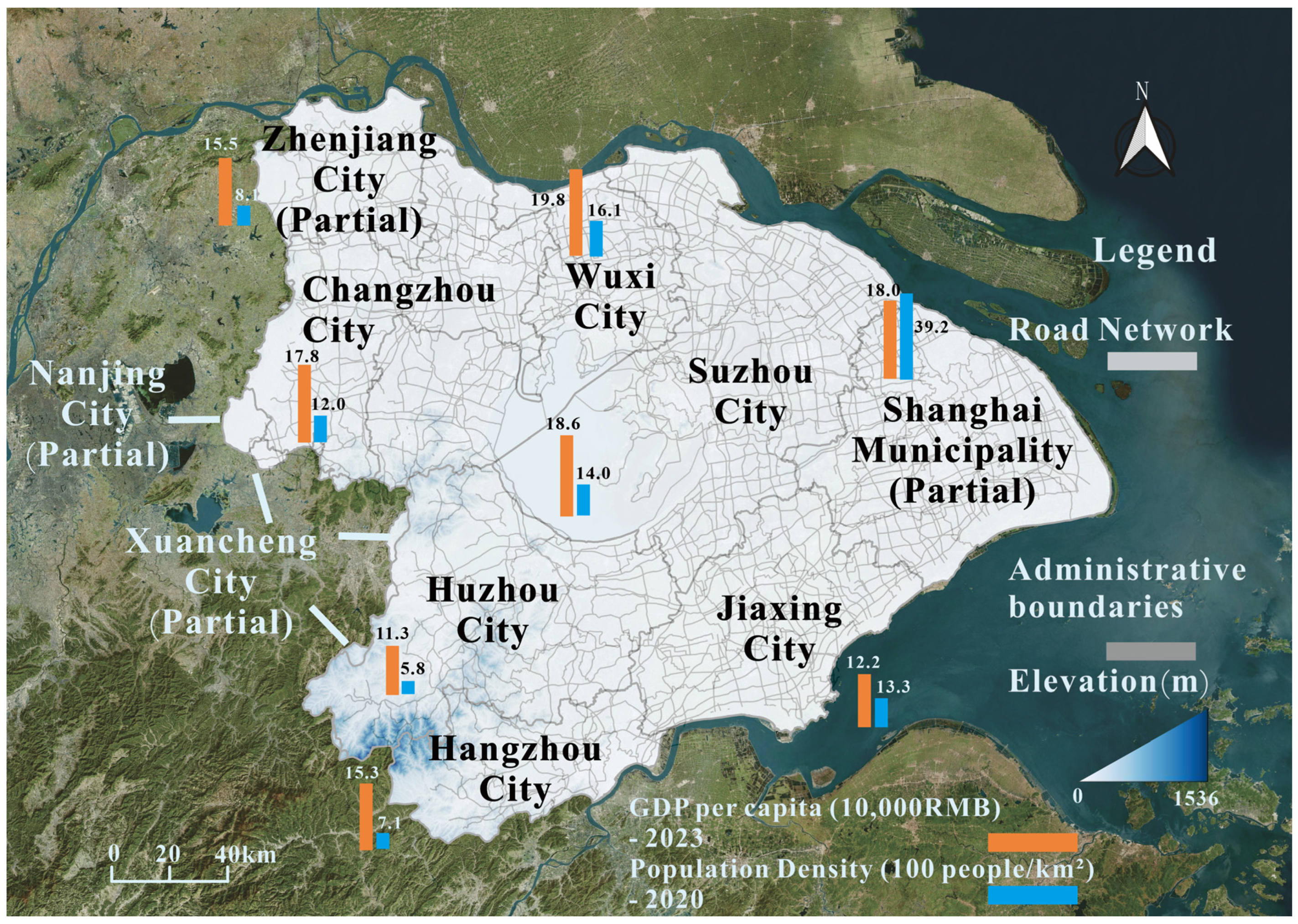
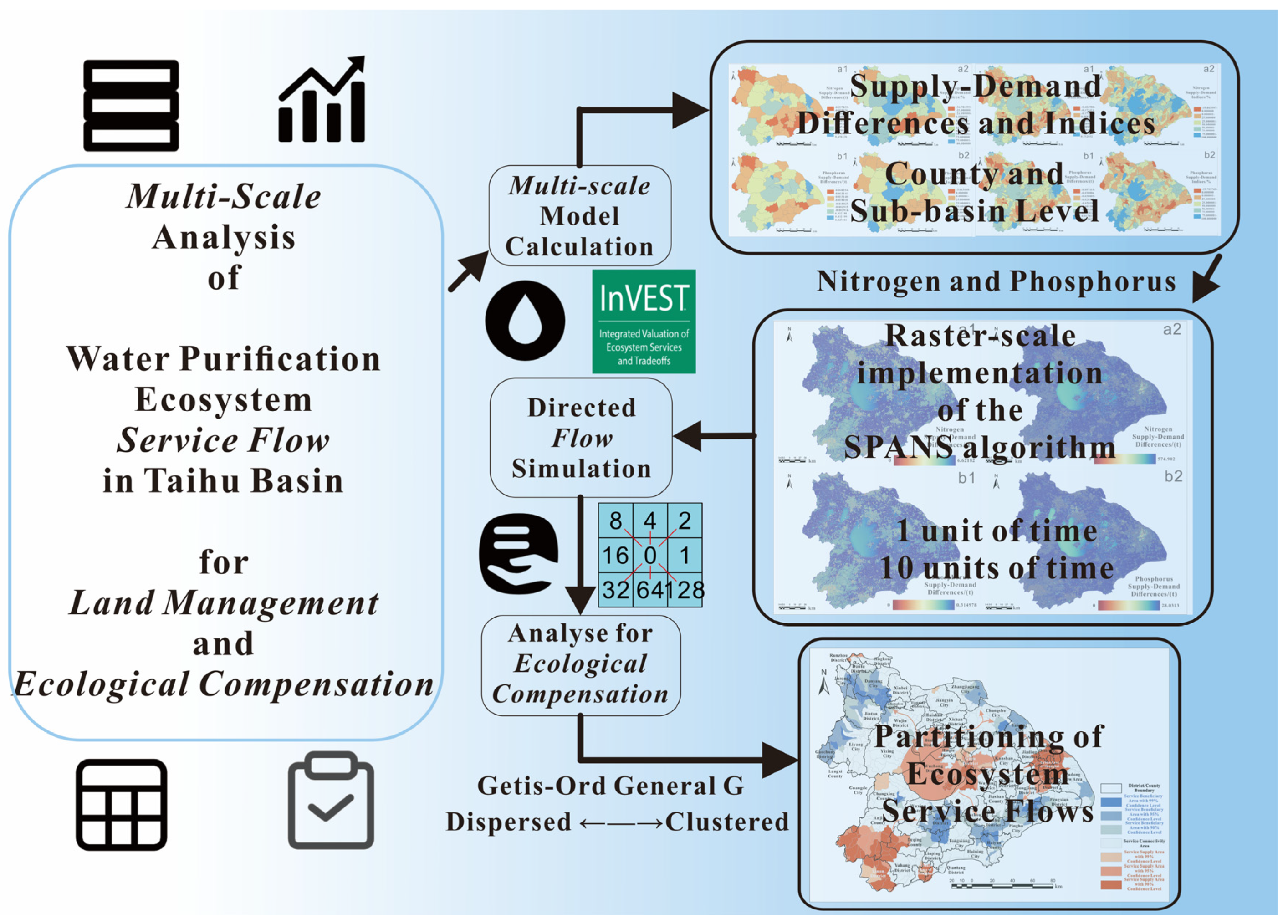
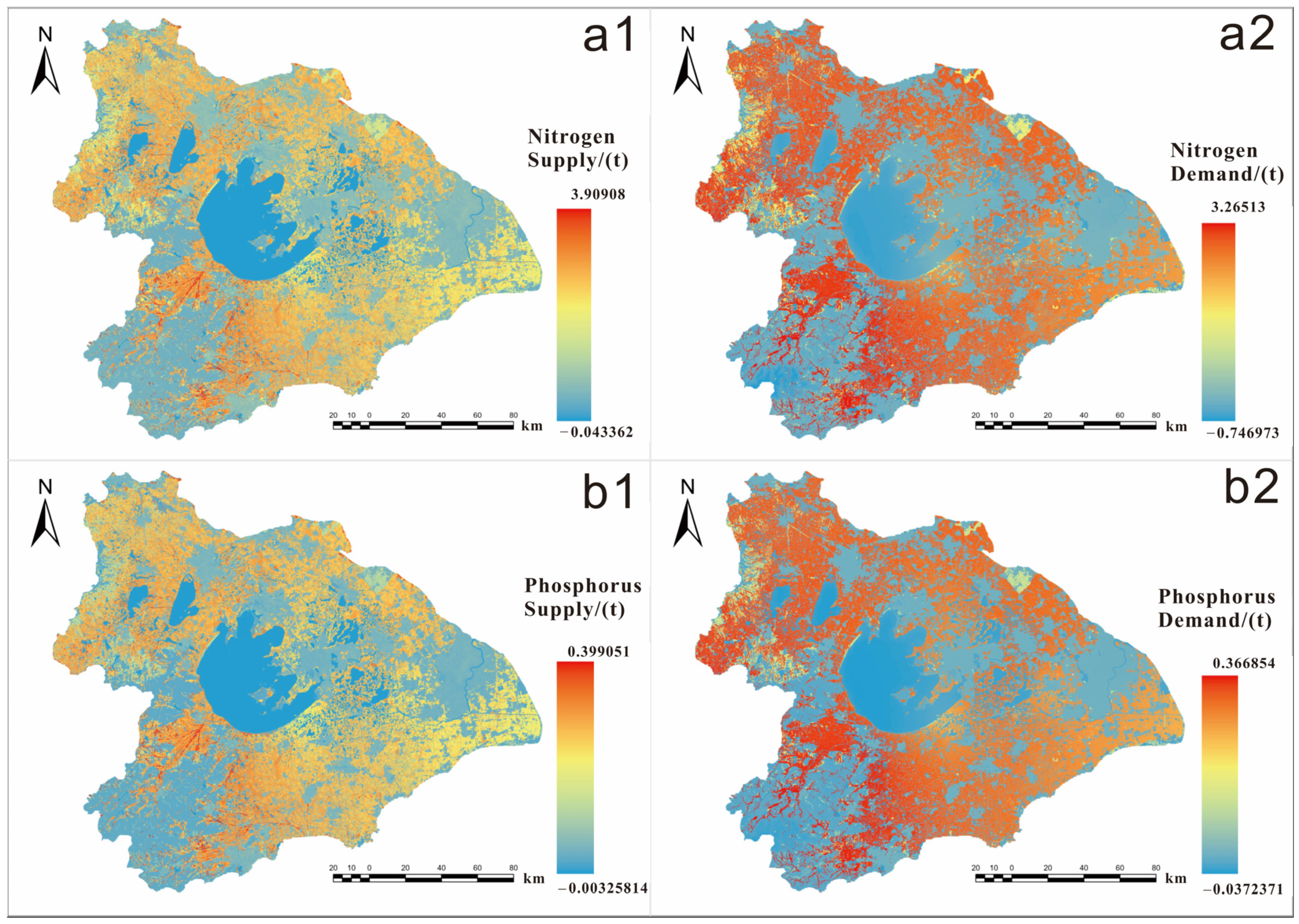


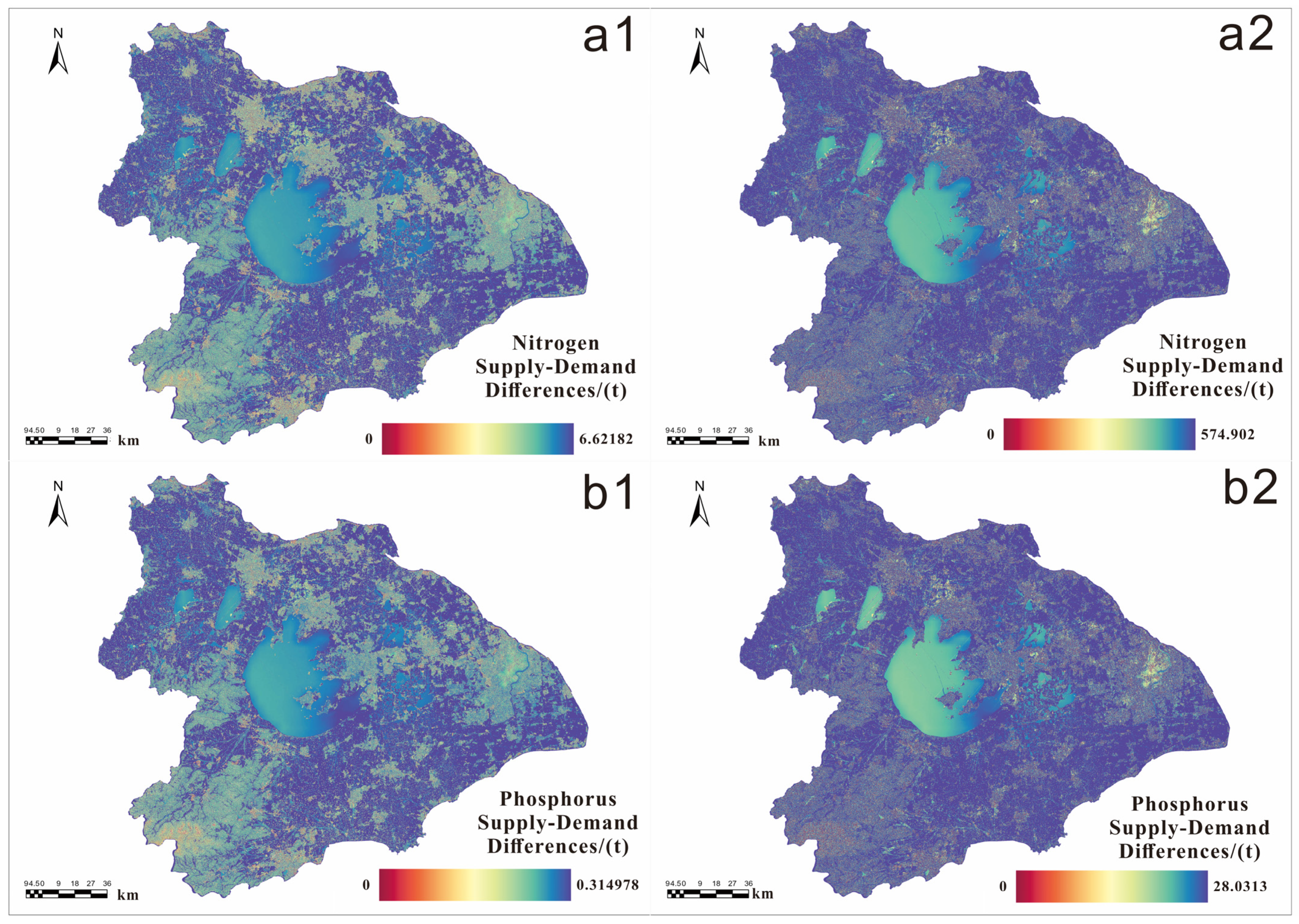
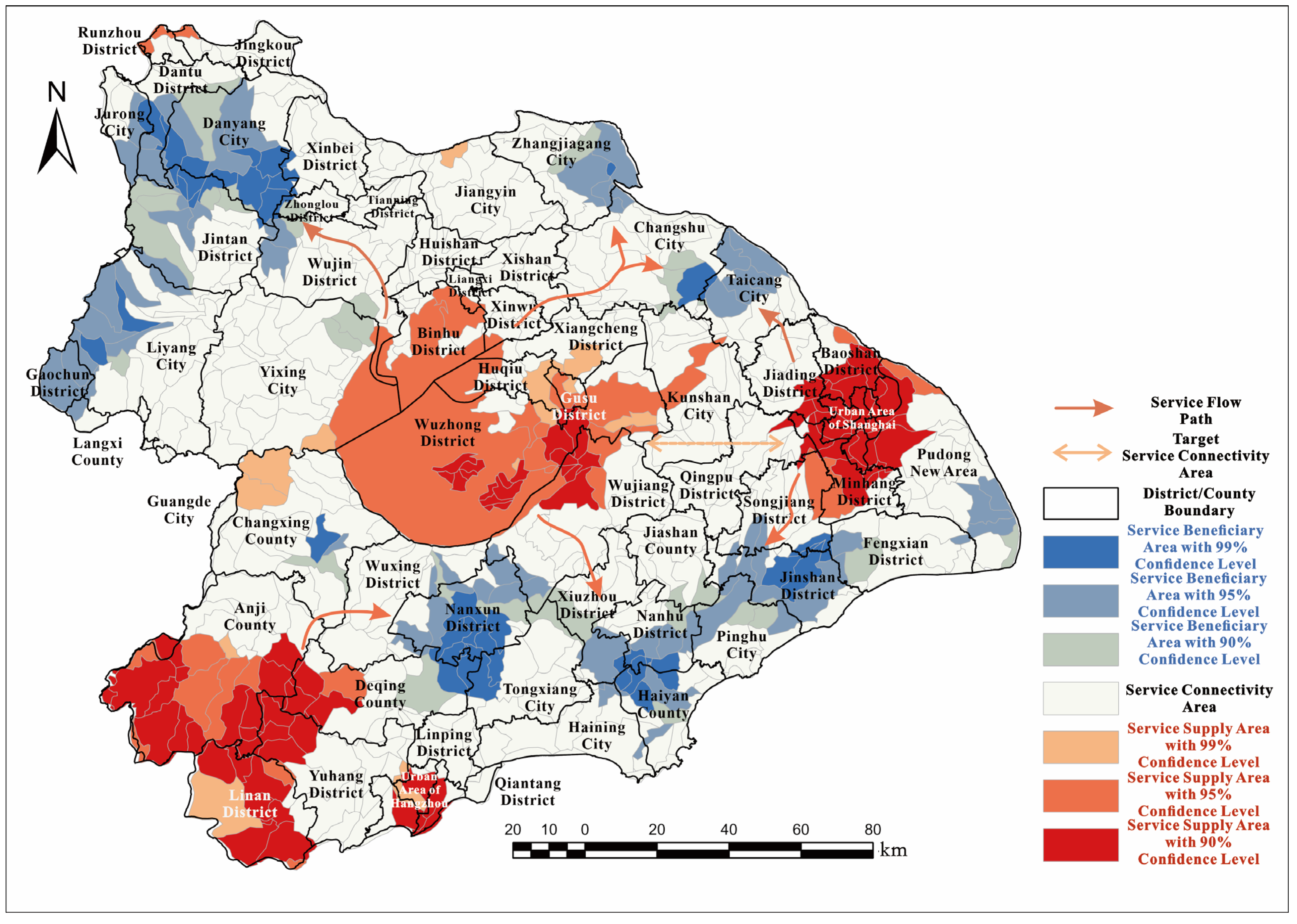
| Dataset | Source | Website | Description |
|---|---|---|---|
| Digital Elevation Model (DEM) | Geospatial Data Cloud (ASTER GDEMV3, 30 m resolution) | (https://www.gscloud.cn), accessed on 1 January 2024 | Used for hydrological analysis to generate flow direction and delineate sub-watershed boundaries, crucial for identifying water flow paths and assessing water purification service distribution. |
| Precipitation and Evapotranspiration Data | National Tibetan Plateau Data Center (1 km resolution) | (https://data.tpdc.ac.cn), accessed on 1 January 2024 | Essential for estimating water budgets and flow dynamics, helping to understand the temporal variation in water demand and supply within the sub-watersheds. |
| Land Use/Cover (LUCC) Data | National Cryosphere Desert Data Center (30 m resolution) | (http://www.ncdc.ac.cn/portal/), accessed on 1 January 2024 | Reclassified to model nutrient load (nitrogen and phosphorus) and filtration capacities of different land types, key for assessing the supply side of water purification services. |
| Watershed Boundaries | National Tibetan Plateau Data Center (1:250,000) | (http://www.ncdc.ac.cn/portal/), accessed on 1 January 2024 | Used to delineate sub-watersheds, serving as analytical units for modeling nutrient flows and assessing supply–demand dynamics in water purification services. |
| Soil Data | National Tibetan Plateau Data Center (China Soil Dataset v1.1, HWSD) | (http://www.ncdc.ac.cn/portal/), accessed on 1 January 2024 | Provides root depth and available water content, crucial for estimating water retention capacity and the filtration of pollutants in hydrological modeling. |
| Biophysical Table | / | / | Contains parameters for nutrient loading and retention efficiencies, essential for quantifying the supply and demand of water purification services in the InVEST model. |
| Year | Total Output (t) | Allowable Load to Water Bodies (t) | Demand (t) | Supply (t) | Supply–Demand Indices (%) |
|---|---|---|---|---|---|
| 1995 | 90,031 | 25,888 | 64,143 | 75,012 | 116.9 |
| 2005 | 88,447 | 26,801 | 61,647 | 73,233 | 118.8 |
| 2015 | 79,741 | 28,077 | 51,664 | 65,895 | 127.5 |
| 2020 | 63,678 | 20,183 | 43,499 | 48,258 | 110.9 |
| Year | Total Output (t) | Allowable Load to Water Bodies (t) | Demand (t) | Supply (t) | Supply–Demand Indices (%) |
|---|---|---|---|---|---|
| 1995 | 8949 | 1294 | 7655 | 7453 | 97.4 |
| 2005 | 8653 | 1340 | 7313 | 7164 | 98.0 |
| 2015 | 7693 | 1404 | 6289 | 6358 | 101.1 |
| 2020 | 6116 | 1009 | 5107 | 4634 | 90.7 |
Disclaimer/Publisher’s Note: The statements, opinions and data contained in all publications are solely those of the individual author(s) and contributor(s) and not of MDPI and/or the editor(s). MDPI and/or the editor(s) disclaim responsibility for any injury to people or property resulting from any ideas, methods, instructions or products referred to in the content. |
© 2024 by the authors. Licensee MDPI, Basel, Switzerland. This article is an open access article distributed under the terms and conditions of the Creative Commons Attribution (CC BY) license (https://creativecommons.org/licenses/by/4.0/).
Share and Cite
Chen, H.; Cai, W. Multi-Scale Analysis of Water Purification Ecosystem Service Flow in Taihu Basin for Land Management and Ecological Compensation. Land 2024, 13, 1694. https://doi.org/10.3390/land13101694
Chen H, Cai W. Multi-Scale Analysis of Water Purification Ecosystem Service Flow in Taihu Basin for Land Management and Ecological Compensation. Land. 2024; 13(10):1694. https://doi.org/10.3390/land13101694
Chicago/Turabian StyleChen, Haoyang, and Wenbo Cai. 2024. "Multi-Scale Analysis of Water Purification Ecosystem Service Flow in Taihu Basin for Land Management and Ecological Compensation" Land 13, no. 10: 1694. https://doi.org/10.3390/land13101694
APA StyleChen, H., & Cai, W. (2024). Multi-Scale Analysis of Water Purification Ecosystem Service Flow in Taihu Basin for Land Management and Ecological Compensation. Land, 13(10), 1694. https://doi.org/10.3390/land13101694






